#multicolored standard poodle
Text
new Grand Champion alert!
✨UGRCH✨ Mistel’s Butcherbird “Shrike” (14 months)
it’s been a long and bumpy road emotionally, but he’s a star in the ring and we haven’t had a bad weekend. win or lose, he’s so fun to handle, and i’ll always love him more than anything (except Denver <3) very proud of my little bird!
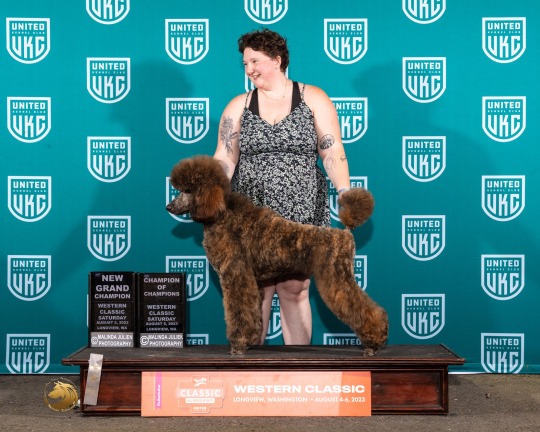
#my dogs#dogblr#dogs of tumblr#shrike#standard poodle#poodle#show dog#ukc conformation#multicolored standard poodle
70 notes
·
View notes
Note
What do you think of the color schemes of the canon miraculous? Also if you could change the color schemes what would you change them to?
they're all fine for the most part. Maybe Roaar could change- I think White would be cool.. to look like a white bengal tiger.. It's clear the kwami was designed to pair with Juleka and thats kinda lame since the extended zodiac kwami are very forced and they are lamely designed at times.
Orikko is underdesigned for a rooster. Tons of kwami need a noses. Duusuu needs a beak. Horse Kwami set a standard for body variations and all of them could be a lot different in body-shape variety. I reeeally Like Baark but they could have a different look would have worked better: I can't ever shake the feeling that they should be more "french" and I so want them to be a poodle-- but on the oppsoite side of the spectrum, Longg should look MORE chinese. Though a little european, wyvern, or quetzalcoatl-esque legendary serpent kwami would be SO NEAT
Roaar should be changed to white or orangey (and Trixx should be a bit more red to balance? Or even more yellowy-orange). Dusuu could be teal-er or have teal accents. But royal blue works well enough, so no real complaints. Again, Baark needs a diffo color entirely- as lots of orange and brown kwami already (Tixx, Orikko/kaalki, Xuppu, Ziggy) and kwami who should be orange (Roaar). Maybe a rusty red or steely blue. idk wtf is up with Longg but if any kwami should be multicolored/rainbow themed, it's them. Xuppu needs a change but I would have to chart out the rest of the kwami to get a good feel for how they should look.
16 notes
·
View notes
Link
Check out this listing I just added to my Poshmark closet: Pet Jacket Size M New Unworn Multicolor best for Standard Poodle or Beagle.
0 notes
Note
What are your thoughts about poodles that aren’t breed standard colors (not Merle! Like multicolored). I’ve seen some on tumblr and think they’re cool but I’m conflicted since they aren’t actually akc standard..
I have no problem at all with multicolors. They are part of the breed’s history. The PCA (parent club) just has a stick up their ass about them and so the AKC does not allow them to show. Without the influence of the AKC show ring multis will likely never be quite the quality you can find in solids. Not to say all solids are better than all multis. But look at a UKC top 5 multi poodle and compare it to a shaved down top 20 AKC solid. You’ll see 2 very different types of dog.
They can still be bred close to the standard, titled, and health tested. That is mostly what I care about. I think the PCA was wrong in trying to cull color from the lines.
I still don’t want one because I show and I don't like a lot of the multi’s heads.
Roman’s mom’s person breeds multicolors. She has a litter of lovely tri pups right now.
Also thank you for calling them multis, not partis. It drives me crazy when people refer to any non solid as parti. A parti is a color pattern just like abstract or phantom.
...fuck merle.
11 notes
·
View notes
Photo


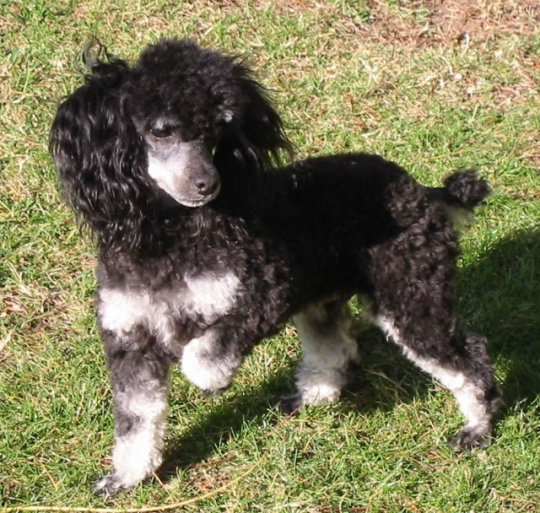
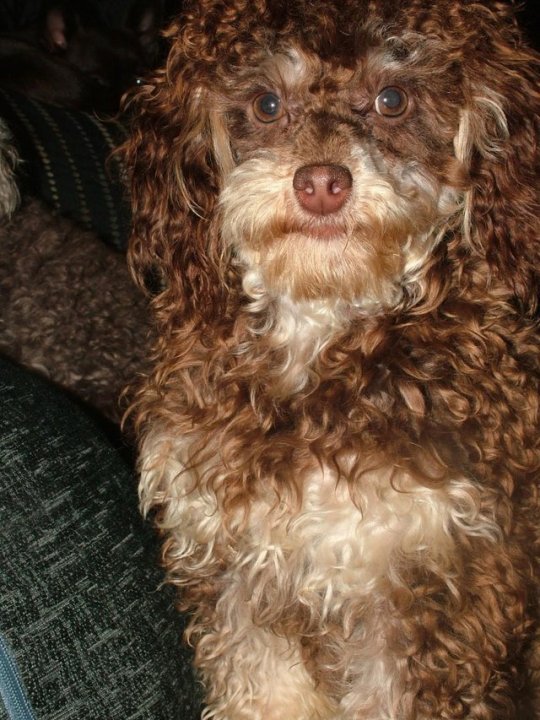

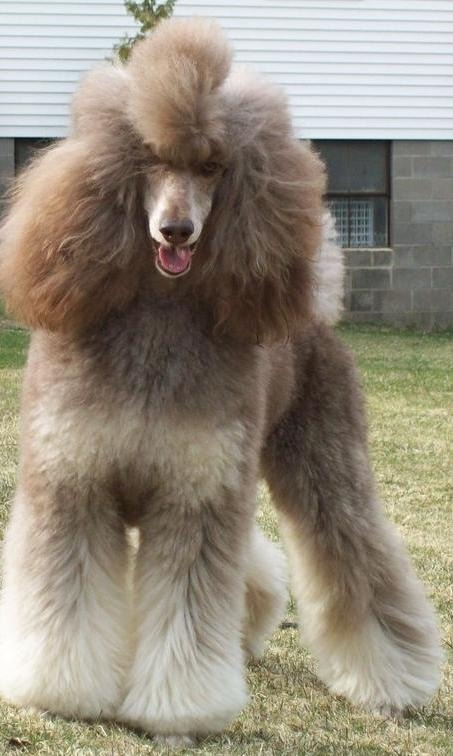
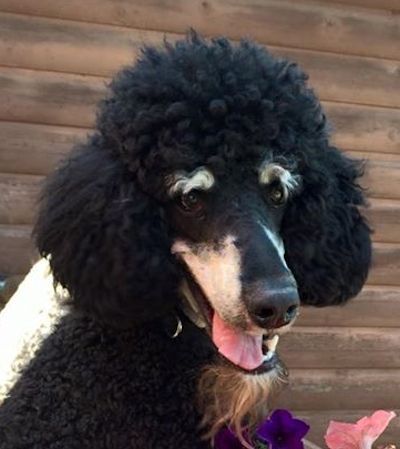



The solid background color of a phantom poodle’s coat may be black, brown, red silver, apricot, white or cream. The second color presents as specific points on the sides of the dog’s muzzle and on his chin, throat, chest, eyebrows, legs, paws and under the tail. These defined markings follow the same pattern as those found on a Doberman pinscher. Some examples of phantom color combinations include black with apricot, red, cream, silver or brown points, red with apricot points, silver with cream points or brown with apricot points.
Although the United Kennel Club recognizes the phantom poodle, the American Kennel Club standard allows only solid colored poodles in the conformation ring. Accepted solid colors include white, black, gray, apricot and café au lait, but parti-colored, phantom and other multicolored poodles are disqualified. The dogs can compete in the American Kennel Club obedience and agility competitions.
The tan point gene (sometimes known as "traditional tan points") is almost the bottom recessive in the agouti series (the only one below it is recessive black, which is very rare). This means that, generally, a dog must have two copies of the tan point gene in order to express tan points, so their A locus genotype must be atat.
[x] [x]
#a dog of a different color#no good dog is a bad color#phantom poodle#multi colored poodle#poodles#dogs#source: google
50 notes
·
View notes
Text
All About Goldendoodles
https://www.centralparkpaws.net/wp-content/uploads/2019/10/What-is-a-goldendoodle-basic-breed-info-golden-retriever-poodle-mix-crossbreed-hybrid.jpg
Yesterday, I had the pleasure of having lunch with my mom.
As always, the subject of dogs came up, and we started talking about Goldendoodles.
My mom currently has a 10-year-old Golden Retriever named Augustine (aka Gussie).
We started discussing the possibility of her getting a second dog before Gussie was too old to deal with a puppy.
Gussie is a very young 10-year-old, but as time goes on, I am sure that her patience with younger dogs will eventually wear thin.
I often think that a well-behaved mature dog can help make puppy training go a lot easier and smoother. I feel that dogs tend to learn faster from one another than they do from their human parents.
My mother is in her 70s and though she is still quite active, lifting a large dog in and out of a car is becoming more and more difficult.
Gussie is 64 lbs. So not a huge Golden, but far from small.
A smaller dog would be better for her, but my mom strongly prefers the Golden Retriever breed.
So, I suggested she look into a Goldendoodle since they are part Golden Retriever; plus, they come in a variety of sizes.
Enter the Goldendoodle
Because I love dogs and learning about them, I told her I would do some digging to see if the Goldendoodle breed would be a good option for her.
Since I “dogsit” for my mom frequently, I needed to make sure it was a breed that would also be compatible with my four-legged part of the family.
Any new dog coming into our family needs to be good with other dogs since we bring them to most family events.
In addition to being great with other dogs, the right dog for my mom needs to be easily trainable, get along with kids, and not too hyper, but energetic enough to go for daily walks.
With my list in hand of what my mom was looking for, I jumped online to see what I could find.
Breed History
Of the different Doodle breeds, the Goldendoodle became popular in the 1990s following the boom of the Labradoodle.
A labradoodle, the goldendoodle’s predecessor
The first documented Labradoodle was initiated because a hypoallergenic dog breed was required for a service dog.
After the successful breeding of the Labradoodle, the Goldendoodle became popular as an excellent hypoallergenic family dog. So, for all of the families wishing they could have a dog but couldn’t due to allergies, the Goldendoodle solved that problem.
In addition to being hypoallergenic, Goldendoodles have the benefit of coming in a wide variety of sizes ranging from under 10 pounds to as big as 90 pounds.
Plus, the Goldendoodle comes in a variety of colors, too.
Types of Goldendoodles
The different types of Goldendoodles are categorized by their size.
There are four main size categories:
A miniature Goldendoodle puppy
Standard – The largest of the varieties.
Medium – The second-largest, usually the size of a medium to large breed dog. These are the only ones that are not in the Poodle size categories.
Miniature – These are fairly small and are the result of breeding a Golden Retriever with a Miniature Poodle. They are often between 10 – 15 inches tall to their shoulder.
Teacup, Micro, or Petite – These are the outcome of breeding a Golden Retriever with a Toy Poodle.
Physical Characteristics of the Goldendoodle
Size
Average Height[1]
Standard – Over 21-25 inches
Medium – 17-20 inches
Mini – 14-16 inches
Teacup – 13 inches and under
Average Weight
Standard – 50+ pounds
Medium – 36-50 pounds
Mini – 26-35 pounds
Teacup – Under 25 pounds
Lifespan
Standard – 10 to 12 years
Medium – 10 to 15 years
Mini – 12 to 14 years
Teacup – 12 to 15 years
Coat Types
There are four varieties of Goldendoodle coat types: curly, wavy, straight, or flat.
Though breeders can strive to produce Goldendoodles with a specific coat style, it is vital to point out that it is not an exact science and puppies of a diverse coat type can be produced in the same litter.
In addition to the style of the coat, the coats vary in texture and length.
Some dogs have silkier coats where other dogs have coarser hair more like the Poodle side of their genes.
Coat color
White fur is also possible but is very rare
There are three primary colors Goldendoodles come in: red, apricot, and cream.
Less common color options are black, chocolate, or multicolored (aka particolored[2]).
Much like the coat type of Goldendoodles, the color combinations that are produced from each litter can vary and include multiple colors.
Eye color
The most common eye color in Goldendoodles is brown.
There are a few anomalies in dogs with other colors such as blue or green, but this is a rare occurrence.
Nose color
Goldendoodles’ noses are black or brown.
Though like with all things Goldendoodle there are always exceptions, so a pinkish-brown nose is rare but possible.
Other Breed Names
There is a number of names the Goldendoodle is also known as:
Groodle
Double Doodle – This is a Goldendoodle mixed with a Labradoodle.
Teddy Bear Goldendoodles aka English Goldendoodle – These are English Golden Retrievers crossed with a Poodle.
Petite Goldendoodle – Miniature versions.
Personality Characteristics
Temperament
When people talk about Goldendoodle’s personalities, it’s usually to say how sweet, fun, and comical they can be.
They are happy dogs and love nothing more than spending time with their families and meeting new friends.
They are one of the most friendly dog breeds, but because of this, they make poor guard dogs.
In addition to adoring human companionship, Goldendoodles can often build quick friendships with other canine companions. Also, not only are they great in multi-dog households, but they usually get along with cats too.
Because Goldendoodles are so smart, they can be trained to live in harmony with a variety of creatures such as rabbits, guinea pigs, or even chickens.
Intelligence
The Goldendoodle is the result of two of the smartest dog breeds, so of course, these guys are going to be quite intelligent.
Because of their intelligence, they can often be trained to do different jobs like therapy or service dog work.
Trainability
Goldendoodles are one of the easiest dogs to train using positive reinforcement.
In fact, Goldendoodles love training as it is a combination of two of their favorite things: family and food.
They are sensitive dogs, so training cannot be punishment-based as it will cause your Goldendoodle to shut down.
This breed is one that strives to please and put a smile on their family’s face.
Exercise Needs
Goldendoodles need exercise like all dogs, but a daily walk is usually enough to keep them happy and healthy.
However, if you are looking for a dog who will enjoy weekend hiking and swimming, the Goldendoodle will have no problem keeping up.
Though Goldendoodles can be enthusiastic when meeting new people, mature Goldendoodles are not an overly energetic breed.
What Goldendoodles Excel At
Though the Goldendoodle is used as service dogs, the breed truly excels at therapy work.
The Goldendoodle’s friendly and sensitive nature makes them a fantastic choice to help the emotional needs of humans.
Therapy dogs can be found in a variety of settings:
A goldendoodle “hard at work” getting read to at a Paws to Read program
Photo by Airman Valerie Monroy
Hospital
Nursing Homes
Counselors/Psychologist offices
Court Rooms
Airports
Libraries
People with therapy dogs can use them in their day to day professions, like counselors, or just in their free time, like volunteering at hospitals or libraries.
In addition to making fabulous therapy dogs, they can also be trained for nose work, agility for fun, flyball, and dock jumping.
Goldendoodles are happy, intelligent dogs, and there are few things they aren’t great at.
Even though they are great at several activities, they are best at being companions.
Just because Goldendoodles are capable of many jobs and games, they do not require specialized training or jobs to be happy.
Health Concerns
Although Goldendoodles were bred to combine the best traits of the two original breeds, the drawback of the Goldendoodle is that they also share negative genetic characteristics as well.
Some common health issues in Goldendoodles are:
Subvalvular aortic stenosis (heart disease commonly found in Golden Retrievers)
Hip dysplasia
Sebaceous adenitis (skin disease common to Poodles)
Eye diseases like retinal atrophy, cataracts, and glaucoma
Addison’s disease
Best Foods for Goldendoodles and How Much do they Eat?
Goldendoodles generally don’t suffer from any specific digestive diseases, though they can have sensitive stomachs when it comes to switching foods.
So ideally, feeding a diet that’s been enhanced with probiotics would be best.
A primary factor when choosing a dog food is the size of the Goldendoodle.
For the Standard, a large breed dog food would be optimal, and for the mini and teacup, a small breed food would be the best choice.
Some food options for food would be:
Click the image for more info
Purina Pro Plan Savor– Contains Probiotics and would be good for any size Goldendoodle.
Instinct Original Small Breed Grain-Free Recipe with Chicken – Contains Probiotics, perfect for toy or miniature.
Core Wellness Grain-Free for Large Breeds– Enriched with joint support supplements, ideal for standard Goldendoodles.
You can find more options, and more in-depth info, in the article about what dog food is best for Goldendoodles.
Grooming and Maintenance
Although Goldendoodles are known for their lack of shedding, they still require regular grooming.
Goldendoodles can tend to become odorous unless bathed frequently, about every 3-4 weeks. Be cautious of over-washing your Goldendoodles as it can cause their skin to become dry and irritated.
Special shampoos for Goldendoodles are available to help manage their fragrant nature.
Shampoos like:
Healthy Breeds Deodorizing Shampoo
Nature’s Miracle Supreme Odor Control
Pet Pleasant Lavender Oatmeal
However, if you have your dog’s haircut short, it will help to relieve some of the smell commonly associated with the Goldendoodle breed.
There are a variety of haircut options.
Not all people opt for a short haircut, there is no real breed standard for the cut, but it is encouraged to have the hair trimmed regularly to keep from mats forming.
Some of the common haircut styles are:
Goldendoodle Lamb cut – Shorter haircut, but not as tight as a true short haircut with rounded cut feet, soft cut around the face, and full fantail.
Even Length Puppy Cut – The hair is cut to the same length on the body and face.
Teddy Bear face – Leaving the longer on the face yet, softly trimmed to give a rounder look.
Goldendoodles are higher maintenance than other breeds when it comes to grooming.
Breeding
The age at which it is best to breed a Goldendoodle depends on the dog itself.
Generally, smaller dogs reach sexual maturity before larger dogs.
Male dogs can be fertile as young as six months and female dogs reach sexual maturity between six months and two years.
Female Goldendoodles should not be bred until after their first season.
Some breeders believe it is best to wait until a female dog is at least two years of age before using them for breeding.
When it comes to the Doodle breeds, there are different generations which significantly impact the outcome of a litter[3].
The first litter of puppies from a Golden Retriever and a Poodle are known as F1. These pups are half of each breed, and though they are Goldendoodles, they tend to shed more than F2 puppies.
F2 Puppies are the result of breeding the F1 dog to a full-bred Poodle. The litter from this union creates a dog with less Golden Retriever traits and more Poodle traits, ultimately resulting a dog that sheds considerably less than other Goldendoodles.
How Many Puppies per Litter?
The average litter size for dogs is between 2 – 12 puppies.
The most significant factor in litter size is the size of the dog.
The general rule is the larger the dog, the larger the litter.
However, like in all things, there’s always going to be the exception to the rule.
So, for Goldendoodles, it very much depends on which of the varieties of Goldendoodle is being bred.
How Much do Goldendoodles Cost?
The cost of a Goldendoodle is dependent on a variety of factors.
Generation
The reputation of the Breeder
Gender
Age
Color
Coat
Location
Though the cost of a Goldendoodle is important, is it is crucial to find a reliable and reputable breeder.
You can typically expect these prices:
Standard $1800 – $3100
Medium $1800 -$2500
Mini $2000 -$2500
Teacup $1000 – $3800
Where to Adopt or Buy a Goldendoodle
If you are looking for a puppy finding a reputable breeder is your best option.
If you aren’t sure where to start in locating a good breeder, contact your local vet clinic as they are a great resource in the canine community.
If you are looking to skip the challenges of puppyhood but would still love to bring a furry friend into your family, there are two great options.
The first option is to go through a rescue organization. Not all rescue dogs have behavioral issues; many dogs are given up because of a family situation.
The second option is to contact a breeder to see if they have any adult dogs for sale.
Breeders will sometimes have older dogs that were formerly used for breeding. Also, some breeders may have slightly older dogs that weren’t adopted from a previous litter or ones returned because they were not a good fit for that family.
Final Thoughts
After spending a substantial amount of time learning about Goldendoodles, I think that this would be a perfect breed for my mom.
They meet all of the criteria she is looking for: ideal size, easily trained, great companion, and makes friends quickly with both humans and canines.
Outside of looking at this breed for my mom, I think that this is a perfect option for new dog parents.
In fact, they are an excellent breed for most families or individuals looking to share their lives with a dog that is intelligent, friendly, and loving.
FAQs
Do Goldendoodles Shed?
Yes, but the shedding is minimal. Goldendoodles shed far less than most other dog breeds.
Are Goldendoodles a Good Dog?
Yes! They are a fun and happy dog breed.
What Health Problems Do Goldendoodles Have?
Because they are a combination of the poodle and Golden Retriever, they, unfortunately, share the negative health traits that are common to the original breeds such as:
Sebaceous Adenitis (skin disease common to Poodles)
Hip dysplasia
Subvalvular aortic stenosis (heart disease common to Golden Retrievers)
Eye diseases like retinal atrophy, cataracts, and glaucoma
Addison’s disease
Do Goldendoodles Bark a Lot?
Though they may bark from time to time, Goldendoodles are rarely known as barky or yappy dogs.
Do Goldendoodles Stink?
They can. Without proper grooming, Goldendoodles will have an unpleasant odor due to the oils in their skin.
Can Goldendoodles Be Left Alone?
Yes, Goldendoodles love and require human companionship, but can be left alone. However, if left alone too often, they may suffer from behavior and emotional problems.
At What Age Do Goldendoodles Calm Down?
8-14 months old for most Goldendoodles[4]. However, their love of meeting and greeting humans never really decreases, but with training their exuberance can be reined in.
Are Goldendoodles Smart?
Very! The two breeds that make up the Goldendoodle, the Golden Retriever and Poodle, are both on the top 10 most intelligent breeds list[5].
What Is the Lifespan of a Goldendoodle?
10-15 Years for the medium variety of the Goldendoodle[6]. The life expectancy for the larger varieties is on the lower end, so 10-12 years, while the smaller versions are at the higher side of the age spectrum, around 12-15 years.
Are Goldendoodles Cuddly?
Very! Goldendoodles love spending time with their humans and cuddles are top on their favorite things-to-do list!
Are Goldendoodles Hyper?
When Goldendoodles are younger, they are more energetic, and even a bit hyper, but with proper exercise and maturity, their energy level can be tampered down.
Are Goldendoodles Easy to Train?
Extremely! Goldendoodles love when their humans are happy, so positive reinforcement training is something they will excel at. However, it is essential to note that Goldendoodles are a sensitive breed and harsh negative reinforcement can cause significant emotional issues in this breed.
How Often Do You Bathe a Goldendoodle Puppy?
About every 3-4 weeks; bathing more frequently can cause skin issues and less regularly can cause bad body odor.
Do Goldendoodles like to Swim?
Yes. Both of the original breeds, Poodles and Golden Retrievers, are great lovers of water. Keep in mind they are more susceptible to hot spots after swimming, so it is vital to be sure they get properly dried off[7].
What Generation Goldendoodle Is Best?
That all depends on what characteristics you are looking for in a Goldendoodle. F1 Generations are 50/50 so more of the Golden Retriever traits can be seen than and F2. The F2 generations have more of the Poodle traits, including minimal shedding.
Do Goldendoodles Get Curlier with Age?
Goldendoodles curly coats come in stronger when they lose their puppy coats.
How Many Hours a Day Do Goldendoodles Sleep?
That depends on their age, but most dogs sleep at least 50% of their day.
Resources
https://www.goldendoodleassociation.com/about-the-breed/sizes/
https://www.goldendoodleacres.com/colors/
https://doodleadvisor.com/which-generation-of-goldendoodle-is-best/
https://doodleadvisor.com/when-do-goldendoodles-calm-down/
https://www.goodhousekeeping.com/life/pets/g4748/top-smartest-dog-breeds/
https://goldendoodles101.com/goldendoodles-and-golden-years/
https://www.akc.org/expert-advice/health/treating-and-preventing-hot-spots-on-dogs/
The post All About Goldendoodles appeared first on Central Park Paws.
from https://www.centralparkpaws.net/pet-facts/goldendoodle-breed-information/
0 notes
Text
pretty boy got a lovely haircut for his show next weekend! he’s maturing so nicely 😭
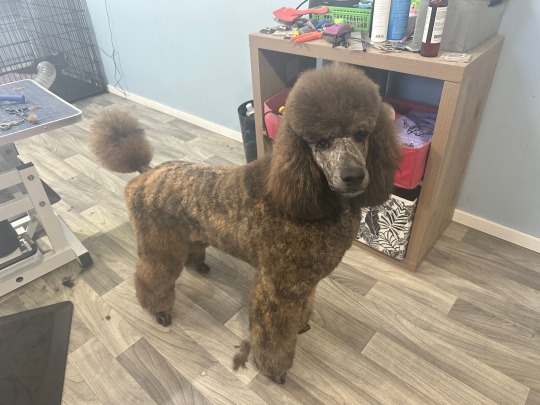

#shrike#my dogs#dogblr#dogs of tumblr#standard poodle#poodle#standard poodle puppy#show dog#show poodle#multicolored standard poodle#brindle poodle
53 notes
·
View notes
Text


Shrike had an amazing show weekend! Over 3 days and 5 shows he won 3 Champion classes and a Best of Breed over some tough competition, and that puts him at 4/5 legs towards his Grand Championship. He’s maturing into such a lovely dog, both in structure and temperament. He’s friendly, easy-going, happy to work, and fucking amazing at settling ringside and traveling. I’m so impressed with my little bird ❤️
Our next show isn’t until August so we’re going to spend the next two months working on ring manners (he’s still super wigglesome for judge exams), coat maintenance, and sport titles. I’m hoping for a RATI, TKN, and CGC. We’ll also keep plugging along with agility foundations and maybe dip our toes into the trial waters by the end of the year.
#my dogs#dogblr#dogs of tumblr#shrike#standard poodle#poodle#standard poodle puppy#show dog#show poodle#multicolored standard poodle#brindle poodle
26 notes
·
View notes
Text

we finished the weekend with shrike’s first 2 Best of Breeds, a Group 2, and a Group 4. not bad for a 7 month old’s first time in the grown-up ring.
13 notes
·
View notes